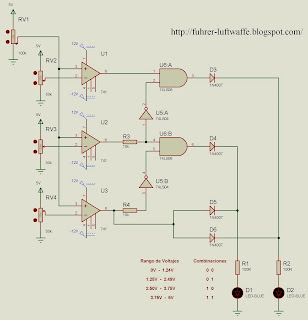
Wonder Continuing the LM741 Op-amp, a very interesting application, which is a configuration as an oscillator. Its operation is simple from an oscillation noise is created sustainable which is amplified by the op-amp has a potentiometer which varies the frequency together with the capacitor C1, as well as resistors R1 and R2 are the ones that control the duty cycle, if we put a potentiometer to replace these two resistances can get a variation of duty cycle, the capacitor C2 is simply placed to eliminate noise in the circuit, the LM741 voltage is 12V maximum.
Used Components.
- 1 Op-amp LM741.
- 1 100uF 100V Electrolytic Capacitor.
- 1 Ohm Potentiometer 1000K.
- 1 Capacitor 1uF 16V.
- 2 51K ohm resistors 1 / 2 Watt.
- 2 Ohm Resistor 330R 1 / 2 Watt.
- 2 LED's.
Used Components.
- 1 Op-amp LM741.
- 1 100uF 100V Electrolytic Capacitor.
- 1 Ohm Potentiometer 1000K.
- 1 Capacitor 1uF 16V.
- 2 51K ohm resistors 1 / 2 Watt.
- 2 Ohm Resistor 330R 1 / 2 Watt.
- 2 LED's.




